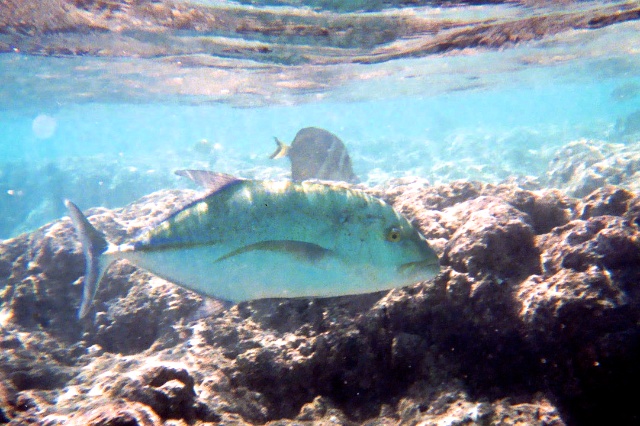Published in the Ocean Watch column, Honolulu Star-Advertiser © Susan Scott
May 13, 2013
NUKU HIVA, Marquesas Islands » I have so many fish under my sailboat, Honu, that I can hear them from inside the cabins. At first the sounds were gentle splashes, but at dawn several loud bangs against the hull sent me flying out of my bunk to see what I hit.
Except the boat wasn’t moving. It’s at anchor in a calm bay.
Peering into the water from the back of the boat, I saw the astonishing source of the crashes. Five 3-foot-long silvery jacks, called ulua in Hawaii, were banging into the boat during strikes on a school of baby jacks trying to hide under the hull.
The whole thing started several days earlier with a community of gooseneck barnacles, offshore crustaceans whose larvae can stick to just about any floating object. It’s common to see these white-shelled, almond-shaped barnacles with the fleshy stalks on bottles, driftwood and plastic debris washed onto Hawaii’s windward beaches.
Before I left Mexico, I had the boat’s hull cleaned of barnacles. After 26 days, though, Honu arrived in the Marquesas Islands with several hundred goosenecks attached to her hull at the waterline. (Anti-fouling paint kept them off the hull.)
Much as I admire the hardy creatures, barnacle bodies slow boats considerably, and Honu is slow at the best of times. Her top speed is a whiplashing 8 mph. The goosenecks had to go.
My crew member Alex volunteered to help me clean them off, so with apologies to the barnacles, we jumped into the deliciously warm water and started scrubbing. Seconds after the barnacles started falling, baby jacks appeared.
“Over here!” I imagined the little fish calling to one another. “It’s raining pupu.”
As we worked, several hundred juvenile jacks gathered beneath the boat, hovering around the propeller and shaft, in the rungs of the boarding ladder and under the rubber dinghy. The bravest of the 4- to 5-inch-long fish swam close to our arms and faces, darting to catch the detached barnacles. I swear those fish were smiling.
Viewing the boat as shelter and a source of free food, the school stayed there, making pleasant little splashing sounds as they changed positions within their school.
And then the big boys found them.
Large ulua are scarce in the main Hawaiian Islands due to overfishing, but here in the Marquesas, as well as in the protected Northwest Hawaiian Islands, fast, strong ulua are abundant.
What a privilege it was to watch these magnificent fish hunt. The five silver-blue ulua below my boat seemed to work as a team, using speedy charges with sudden direction changes to confuse and separate their prey. As the school panicked and broke up, the hunters nabbed the stragglers.
In those drives, the big jacks occasionally slammed into the boat. I had no idea that ulua would smash solid objects during their breakneck hunts. Later I read that ulua have been known to grab and rip away divers’ snorkel tips and fins, and also ram reef crevices during a drive, coming out with coral scrapes on their skin.
Before I sailed to the Marquesas, I didn’t know jacks. I’m learning fast.
 Ulua in Hanauma Bay, Oahu, Hawaii
Ulua in Hanauma Bay, Oahu, Hawaii